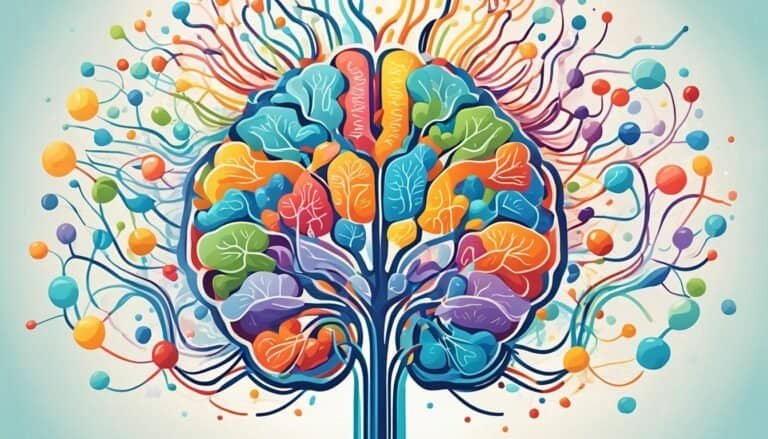Exploring Self-Determination Theory (Deci & Ryan)
Have you ever thought about why some people love challenges and others avoid them? This question takes us into the world of Self-Determination Theory (Deci & Ryan). This theory helps us understand what drives us. Edward Deci and Richard Ryan created it. They look at how both inside and outside forces affect our actions and choices.
Self-Determination Theory says we all need three things: to feel in control, to be good at what we do, and to feel connected to others. These needs are key to our happiness.
This article will guide you through the history and main ideas of Self-Determination Theory. We’ll see how it helps in education, work, and sports. It also shows its big impact on our personal lives and mental health.
Key Takeaways
- Self-Determination Theory includes six mini-theories that explain motivation and personality.
- It focuses on three basic needs: autonomy, competence, and relatedness.
- The Cognitive Evaluation Theory shows the power of doing things for ourselves.
- Our environment greatly affects our motivation.
- Studies prove that meeting these needs is good for our mental health.
- SDT’s effects are seen worldwide, showing how our surroundings shape us.
- Knowing what motivates us can make us happier, more creative, and more confident.
Understanding the Basics of Self-Determination Theory
Self-Determination Theory (Deci & Ryan) is key to understanding why we do things and how we grow. It breaks down motivation into two main types: intrinsic motivation and extrinsic motivation. Intrinsic motivation comes from inside us, driven by our interests and values. On the other hand, extrinsic motivation comes from outside, like rewards or what others expect.
How these motivations interact is vital for our actions and meeting our psychological needs. Self-Determination Theory says we have three basic needs: autonomy, competence, and relatedness. These needs help us feel good and stay motivated. Studies show that meeting these needs helps us manage ourselves better and build strong relationships.
Knowing the difference between intrinsic and extrinsic motivation helps us see how they impact our work and performance. When we’re more intrinsically motivated, we’re more interested, creative, and keep going. But, extrinsic motivation that’s not very autonomous can make us less engaged and less happy. So, it’s important to think about motivation when looking at how we learn, work, and interact with others.
Self-Determination Theory has a lot of evidence supporting its importance in understanding motivation. As researchers keep studying it, we’ll learn more about how to motivate people in different areas.
Historical Background of Self-Determination Theory (Deci & Ryan)
The story of Self-Determination Theory (Deci & Ryan) started in the 1970s. Psychologists Edward Deci and Richard Ryan teamed up at the University of Rochester. They made big strides in motivation research, especially with Deci’s Soma cube puzzle experiment.
This experiment showed a surprising result: giving money rewards actually made people less motivated. This went against the old ideas of the time.
In 1985, their work led to a big book. It shared the history of SDT and offered a new view on motivation. SDT grew to include more than just intrinsic motivation. It showed how both internal and external factors play a role in our motivation.
Autonomy became key to feeling good. This change marked a big shift in how we think about motivation, moving away from just looking at external controls.
SDT has grown to fit into many areas, like well-being and relationships. It’s used all over the world, showing its strength and flexibility. Scholars around the globe support SDT, making it a solid framework for understanding human motivation and well-being.
As SDT grows, it’s becoming part of a bigger picture in life sciences. Autonomy is still at the heart of SDT, helping shape our personalities and behavior. This shows how we balance outside forces with our own values, shaping our motivation.
The Core Concepts: Autonomy, Competence, and Relatedness
Self-Determination Theory is built on three key ideas: autonomy, competence, and relatedness. These needs are vital for strong motivation. They help improve well-being and personal growth.
Defining Autonomy in Motivation
Autonomy means feeling in charge of what you do and decide. When you feel you act on your own, you’re more satisfied and motivated. To support autonomy, listen to what people want, understand their views, and give them choices.
Studies show that being more in control of your actions leads to reaching goals. This is true for health and personal growth.
Understanding Competence as a Psychological Need
Competence is about feeling you can do things well. It drives you to beat challenges and get better at skills. Having the right challenges and feedback is key to feeling competent.
Being in a place that helps you grow in competence boosts motivation and happiness. This leads to sticking with different tasks.
The Importance of Relatedness in Human Connections
Relatedness is about wanting to be close to others and feeling you belong. Being part of a strong social circle makes you feel good and motivates you. People do well in places where they have supportive friends.
Creating bonds through caring and understanding builds a strong sense of relatedness. This makes sure your basic needs are met.
| Psychological Need | Definition | Methods of Support |
|---|---|---|
| Autonomy | Feeling in control of actions and decisions | Acknowledging preferences, providing choices |
| Competence | Sense of mastery and effectiveness | Offering challenges, providing feedback |
| Relatedness | Need for social connection and belonging | Building relationships, showing empathy |
Types of Motivation: Intrinsic vs. Extrinsic
Understanding the difference between intrinsic and extrinsic motivation helps us see how people engage and perform. Each type affects behavior and satisfaction in unique ways.
The Role of Intrinsic Motivation in Engagement
Intrinsic motivation comes from enjoying an activity for its own sake. It leads to lasting engagement. People do tasks because they find them valuable, which makes them happier and perform better.
Studies show teachers boost students’ intrinsic motivation. This improves confidence and mood in competitions. Research also finds that people with schizophrenia do better in activities they like, improving their thinking and feelings.
Comprehending Extrinsic Motivation and Its Effects
Extrinsic motivation is about doing things for rewards or to avoid bad outcomes. While rewards can get people moving, too much focus on them can reduce the joy of doing things. Deci and Ryan (1980) found that people lose interest in activities once rewards stop.
For example, quitting smoking is influenced by both intrinsic and extrinsic motivations. A study by Curry et al. (1997) showed how these motivations interact. A review by Cerasoli et al. (2014) also found that both intrinsic motivation and rewards affect performance over time.
Autonomous Motivation vs. Controlled Motivation
Knowing the difference between autonomous and controlled motivation is key in psychology and personal growth. Autonomous motivation comes from within, pushing people to act based on what they value and enjoy. This kind of motivation makes people more engaged and happier.
On the other hand, controlled motivation comes from outside forces like rewards or duties. People might do tasks, but they might not really want to. Studies show that autonomous motivation leads to better persistence and results in many areas.
A study with 140 college students looked at how these motivations affect health behaviors. It found that autonomous motivation really helped with both planning and doing health behaviors. Controlled motivation had a smaller effect. Planning was a big link between autonomous motivation and doing things.
The study put students into groups based on their plans, not changing how these motivations worked. It showed that students with strong autonomous motivation did better in school. But, students with strong controlled motivation or no motivation did worse.
| Motivation Type | Empirical Evidence | Behavioral Outcomes |
|---|---|---|
| Autonomous Motivation | Significant positive effects on intentions and behaviors | Higher performance, persistence, adaptive outcomes |
| Controlled Motivation | Modest effects compared to autonomous motivation | Lower performance, risk of dropout |
| Amotivation | Associated with high levels of controlled motivation | Negative outcomes, disengagement |
Understanding these motivation types is key for good mental health and doing well in school. Focusing on autonomous motivation can make people more engaged and happy for the long term.
Self-Determination Theory (Deci & Ryan) and Psychological Needs
Self-Determination Theory is key to understanding how our psychological needs affect our well-being. It focuses on autonomy, competence, and relatedness. These are vital for motivation and personal growth in life.
Impact of Psychological Needs on Well-Being
Meeting our psychological needs is crucial for well-being. Having control over our choices, growing in skills, and forming deep connections are key. These factors boost our motivation.
Studies show that when these needs are met, people feel more satisfied and engaged in life. In schools, giving students control leads to more motivation and better grades. This shows how important it is to meet these needs for well-being.
Effects of Thwarted Needs on Mental Health
On the other hand, blocked psychological needs can harm mental health. Feeling frustrated, anxious, or depressed can happen when these needs are not met. It’s vital to create spaces that support our autonomy, skills, and connections.
For example, workplaces that don’t offer feedback or self-control can see lower morale and productivity. Understanding these needs helps in making better interventions. This can improve mental health and overall well-being.
| Psychological Need | Impact on Well-Being | Effects of Thwarting on Mental Health |
|---|---|---|
| Autonomy | Enhances self-motivation and personal satisfaction | Leads to feelings of helplessness and frustration |
| Competence | Fosters a sense of accomplishment and mastery | Contributes to anxiety and low self-esteem |
| Relatedness | Promotes social connections and support | Results in loneliness and isolation |
Applications of Self-Determination Theory in Various Fields
Self-Determination Theory (SDT) is used in many areas. It shows how well it works in making people more motivated. In education, work, and sports, SDT helps by focusing on what people need to feel good.
Self-Determination Theory in Education
In schools, giving students control and making them feel capable boosts their motivation. Using projects, letting them choose their path, and focusing on what they like makes learning exciting. When students feel in charge, they dive deeper into their studies and do better.
Usage in Workplace Motivation
At work, SDT can make employees more motivated. A supportive place that lets people make their own choices is key. By focusing on what matters to them, rather than just rewards, companies can make workers happier and more productive. People who feel they can do well and make their own choices put more effort into their jobs.
Implications for Sports Coaching
In sports, SDT is vital for getting the best out of athletes. Coaches who support their athletes’ freedom, skill, and connection with others create a winning environment. Athletes who motivate themselves naturally do better, keep going longer, and enjoy their sport more. This leads to better performance overall.
| Field | Application of SDT | Key Benefits |
|---|---|---|
| Education | Fostering autonomy through personalized learning | Increased motivation, engagement, and academic success |
| Workplace | Creating supportive environments for autonomy | Enhanced job satisfaction and productivity |
| Sports Coaching | Encouraging athlete autonomy and competence | Improved performance and enjoyment of the sport |
The Six Mini-Theories of Self-Determination Theory
Self-Determination Theory (SDT) has six mini-theories that help us understand motivation better. They look at both intrinsic and extrinsic motivation. They show how important it is to feel in control, skilled, and connected.
These theories help us see how motivation works in different places like schools, workplaces, and sports. They give us new ways to think about motivation.
Cognitive Evaluation Theory Explained
Cognitive Evaluation Theory (CET) talks about how our surroundings can boost or lower our drive. It says that feeling supported in what we do and feeling good at it makes us more motivated. This theory is key for making places that help people stay motivated.
It’s important to give feedback that makes people feel more in charge, not less.
Organismic Integration Theory Overview
Organismic Integration Theory (OIT) looks at how external motivation turns into something more internal. It shows that our environment plays a big role in how we choose to be motivated. OIT helps us create better places for learning and working.
Basic Psychological Needs Theory: A Deep Dive
Basic Psychological Needs Theory (BPNT) is a big part of SDT. It says we need to feel in control, skilled, and connected to grow and be happy. Meeting these needs helps us stay motivated and healthy over time.
The mini-theories of SDT show us the complex ways people get motivated. They help us make better choices in education, work, and sports.







